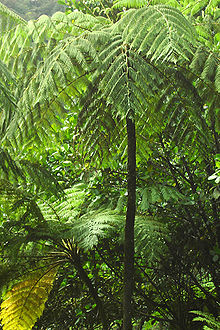Cyatheaceae
| Cyatheaceae | |
|---|---|
 |
|
| Scientific classification | |
| Kingdom: | Plantae |
| Division: | Pteridophyta |
| Class: | Pteridopsida |
| Order: | Cyatheales |
| Family: |
Cyatheaceae Kaulfuss, 1827 |
| Genera | |
|
Cnemidaria |
|
| Synonyms | |
|
|
Cnemidaria
Cyathea
× Cyathidaria
Alsophila
Sphaeropteris
†Alsophilocaulis
†Cibotiocaulis
†Cyatheocaulis
†Oguracaulis
The Cyatheaceae are the scaly tree fern family and include the world's tallest tree ferns, which reach heights up to 20 m. They are also very ancient plants, appearing in the fossil record in the late Jurassic, though the modern genera likely appeared in the Cenozoic. Cyatheaceae are the largest family of tree ferns, including about 500 species. Cyatheaceae and Dicksoniaceae, together with Metaxyaceae and Cibotiaceae, are a monophyletic group and constitute the "core tree ferns". Cyatheaceae are leptosporangiate ferns, the most familiar group of monilophytes.
The Cyatheaceae usually have a single, erect trunk-like rhizome (stem). Their fronds (leaves) are also very large, some of the largest in the plant kingdom. Some species have fronds reaching 3–4 m in length, and have a final crown width of some 6 m. The fronds are circinate before unfolding and usually pinnately or bipinnately compound, with deeply pinnately lobed leaflets. The large leaves are covered in scales and hairs, and bear sori (spore clusters) on their undersides. The sori are often covered by a flap of tissue called an indusium, a useful characteristic for classifying the Cyatheaceae. Some indusia are cup-shaped (cyatheoid), while others are hood-shaped (hemitelioid), enclose the sorus (sphaeropteroid), or scaly. Like most ferns, members of the Cyatheaceae are homosporous. Cyatheaceae are found in both New and Old World tropical wet montane forests and cloud forests, with some species extending into south-temperate regions. Most Cyatheaceae are terrestrial, with one sometimes being epiphytic and others having a creeping habit, but these are exceptions to the family norm.
...
Wikipedia
